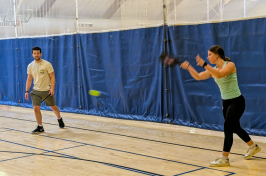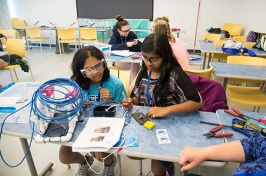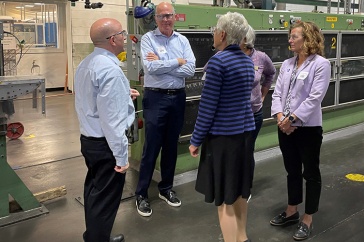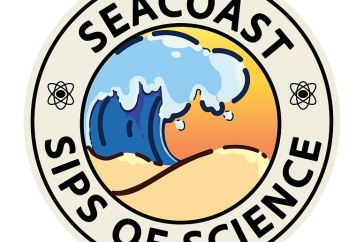
A tow cage in the Mediterranean holds tuna on their way to a fattening farm in Sicily
The Pura Vida is riding the swells off Prince Edward Island on a rare clear August afternoon. An excited crew of fishermen and UNH scientists cluster to watch first mate Paul Murray struggle to rein in a giant bluefin tuna. Caught by rod and reel, this 1,000-pound fish has been hauling at the other end of a taut line of monofilament for the better part of an hour. That was the easy part. Now it's Murray's job to encourage this massive, agitated fish to settle down.
While Murray is trying to bring the fish close enough to slip a harness over its head, the giant tuna is pulling back with a force that many anglers have likened to a moving car. From the wheelhouse, Captain Ewen Clark and fisherman Cookie Murray are calling out directions, coordinating the motion of the boat to match the first mate's and giving him some leverage in this deep-sea tug-of-war.
Suddenly, the struggle is over, and the bluefin is securely lashed to the starboard side of the vessel, swimming easily along. This is the moment Molly Lutcavage has been ready for all day. She reaches over the side wielding a T-shaped tagging stick, its tip loaded with a black nylon dart, and calmly waits for a clear shot to push the dart into the base of the tuna's second dorsal fin. When the fish is released, this combination data logger and satellite transmitter will track the tuna's journey over the coming year, recording depth, temperature and location as the fish swims in a range that extends south to Brazil and east to the Mediterranean Sea.
The leviathan stares at Lutcavage as she leans over the side. It's an experience that the director of UNH's Center for Large Pelagics Research has become familiar with over the years, but one she will never get used to—looking into the immense dark eyes of a creature of the abyss. A 20-year-old giant that has crossed the Atlantic many times and has seen things she can only imagine. A fish so iridescently beautiful that when it breaks the surface on a sunny day like this she thinks of the aurora borealis. A fish so delicious that it is likely to become commercially extinct—a destiny Lutcavage hopes her research can help it evade.

HOLD STILL: Walt Golet '09G prepares to tag a
giant bluefin tuna, right, with an archival pop-up
satellite tag that will track the fish's movements
in the months to come. This fish is one of
hundreds tagged by UNH researchers as part of a
program to save a highly valuable and rapidly
disappearing giant of the deep.
On a campus set 12 miles from the ocean in a state that by the most generous reckoning claims 18 miles of coastline, one might think that an internationally acknowledged fisheries science expert is an anomaly. In fact, Lutcavage is part of a large community of UNH researchers, professors and students who are working to address the incredibly complicated, often contentious and thoroughly global problem of how to reverse the decline of the fisheries.
The Atlantic bluefin is only the latest installment in an old fish story, one that's been told many times over: consumers demand more fish, fishermen catch too much fish, fish run out. As this story unfolds, it almost always includes fierce arguments in which fishermen and governments clash. fingers get pointed, not only between these groups, but to other possible causes for the fishery's collapse, like pollution or climate change. When the fish finally disappear, they take with them jobs, industries, food security—sometimes even the health of ocean ecosystems, in which the disappearance of one species can upset an intricately balanced food web.
In this breach are UNH scientists like Lutcavage, who believe that if we are not to be the last generation to enjoy the sight or taste of fish like bluefin, cod or flounder, we need to make science-based decisions that balance the fisheries' health with our need to feed a hungry planet. Their work spans a diversity of fields and tries to overcome challenges like reliably measuring an underwater population with a many-thousand-mile range and sustainably developing ways to farm fish in the ocean.
And while overfishing is often singled out as the primary driver in pushing a third of the world's fisheries into collapse, UNH scientists like Lutcavage don't see fishermen as the enemy. Instead, they view them as colleagues with the knowledge and skill that's needed to solve problems. They may come to their work on the water for different reasons, but the New England fishermen and UNH scientists who work together have the same goal in mind: healthy fisheries, capable of feeding generations to come.
"I have to say it was watching 'Sea Hunt.'" Molly Lutcavage acknowledges the source of her inspiration to become a marine biologist with a sheepish laugh. But if Lloyd Bridges' ocean adventures tempted Lutcavage to consider a life aquatic back in the '60s, it was creatures like the bluefin tuna that hooked her in graduate school.
Possessed of considerable mega-fauna charisma, the bluefin can cross the Atlantic at the tender age of 2, dive to depths of 3,900 feet, cruise along at 20 miles per hour and crank up its digestion to speed-eat any unexpected bounty it may swim across. It's also regarded as uniquely delicious and is therefore pricey; at Tokyo's Tsukiji fish Market, the record is $173,600 for a single fish.
  |
| OUTPATIENT SURGERY: Molly Lutcavage implants an archival transmitter into a "tiny," a juvenile bluefin tuna, before releasing it. Research by Lutcavage and colleagues has shown that tuna swim back and forth across the Atlantic, starting at age two.
|
At the center, Lutcavage works with faculty, students, fishermen and colleagues from around the world to study the movements and physiology of the large ocean animals that roam the northwest Atlantic. A partnership of UNH and the National Oceanic and Atmospheric Administration, the center develops science and technology that can be used to protect and, when appropriate, harvest the animals. With its high price and extreme wanderlust, the Atlantic bluefin tuna poses a particular challenge.
"The bluefin is pursued by the fishing fleets of many nations, so managing the fishery requires international cooperation," notes Lutcavage. While the International Commission for the Conservation of Atlantic Tuna is supposed to ensure such cooperation, the eastern and western stocks are harvested in completely different ways.
If they are lucky enough to land it, U.S. and Canadian fishermen are allowed only one-twelfth of what their counterparts in the Mediterranean may haul up each year. Westerners must use rod and reel or harpoons. In the East, purse seiners guided by spotter planes and helicopters scoop up hundreds of schooling tuna at a time in drawstring nets. They keep these fish in open-ocean "fattening" pens to improve their commercial quality and avoid flooding the market and driving down the price.
"The justification for such aggressive practices is that there are two stocks—an Atlantic stock in the West and a Mediterranean stock in the East—that were assumed to mix very little," says Lutcavage. "There's a presumed barrier between the two at 45 degrees longitude. The assumption is the eastern stock is larger and can take the added pressure and that the western is failing."
But Gulf of Maine fishermen have claimed for years that their fish routinely swim across the Atlantic. Twelve years ago, Lutcavage began working with fishermen to tag and track the bluefins roaming the northwest Atlantic with a range of old and new technologies.
The center's "Tag a Tiny" program has enlisted the help of more than 300 anglers to attach simple identification tags that can tell about the beginning and end of a juvenile tuna's journey. To help fill in the blanks about what happens in between, Lutcavage's team also tags tuna with surgically implanted archival tags that store information.
Pop-up satellite tags that ride on the tuna's back, capturing information about light, ocean temperature and depth, are the most recent addition to Lutcavage's tagging tool chest. Once the tags pop off and reach the surface, they begin to transmit data via satellite back to Lutcavage's computer. In 2005, she attached pop-up tags to two giant tuna of similar size in the same location off Nova Scotia. The fish were recaptured nearly a year later in almost the same location. In the interval, one had traveled east to Spain's Bay of Biscay, the other to the Gulf of Mexico.

Regardless of which approach she uses, however, the data has been pointing to the same general conclusion. "They swim back and forth across the Atlantic," she says, "to different areas." Her findings support an emerging view that there are more than two stocks.
Lutcavage's further research is aimed at providing a finer scale of detail on the tuna's travels and reproductive habits. Overfishing is just one of many issues to consider. "Since the turn of the century, when people started tracking the climate, we have seen big shifts in bluefin tuna population," she says. "Historic Brazilian and Nordic fisheries have disappeared completely, and what was left of the New England giant bluefin fishery seems to have shifted offshore and north to Canada. Is it really just overfishing, or have shifts in prey and oceanographic conditions changed their distribution? This is an important part of the puzzle."
Pingguo He is explaining what can happen when the creativity of scientists and fishermen meet. On the monitor in front of him is a photo of a plastic tub on the deck of a dragger, full of freshly caught shrimp. "You see?" He says, "there are no fish to sort. The catch is clean." An accomplished photographer, He can make almost anything look good. But what's compelling about this particular image is what's missing.
"Look at the difference." The research associate professor in the Institute for the Study of Earth, Oceans, and Space clicks on another photo: small, dusky herring lie among the shrimp. "fishermen have to sort out these fish," he says, "and throw them back, usually dead."
  |
| NET RESULT: Pingguo He works with fishermen to reduce the bycatch hauled up by shrimp trawlers. The modified plastic sorting grid allows shrimp too small to sell to escape. A clean catch of market-size shrimp is the result, left. |
Otherwise known as "bycatch," what fishermen throw back includes seabirds, turtles, marine mammals, fish too small or commercially unappealing to be sold, even bottom dwellers like corals and sea cucumbers. Nationwide, the amount of bycatch that gets thrown overboard can add up to 20 percent of the total catch, according to a study co-authored by professor of natural resources Andrew Rosenberg.
Rosenberg has been embroiled in the controversy of fisheries management on both sides of the Atlantic for 25 years. Before coming to UNH, he served on the faculty at London's Imperial College of Science and Technology and later as northeast regional administrator and deputy director in NOAA's National Marine fisheries Service.
"Bycatch undermines our efforts to recover depleted marine resources," says Rosenberg, who calls for legal limits on bycatch. "And it undermines a fisherman's bottom line—removing bycatch is wasted labor." He believes that with the right incentives, fishermen will take advantage of new technology to reduce bycatch.
Pingguo He could not agree more. The son of a Chinese fisherman, he grew up to study fisheries science in the wake of China's cultural revolution. Today, he relies on the entrepreneurial nature of Gulf of Maine fishermen to find creative solutions to reducing bycatch, particularly with shrimp trawlers.
"Shrimp fishing is notorious for bycatch, especially in tropical areas, where for every 10 pounds of catch, there could be nine pounds of bycatch," explains He. The problem is much less severe for coldwater shrimp fisheries like the Gulf of Maine, but even with innovations like the Nordmore grate, a device that keeps larger fish from entering a trawl net, bycatch of small fish and shrimp too small to sell are still a problem, one that He would like to solve with the help of local fishermen and groups like the Northeast Consortium.
"Modern fishing gear is really just a modification of the kind of gear that was designed and developed hundreds of years ago," observes Chris Glass, consortium director and UNH research professor of zoology. "We use stronger materials, faster vessels and better electronics, but the way we catch fish is unchanged. What would we design if we started from scratch?"
The consortium, a UNH-based group of Gulf of Maine research institutions, brings scientists like He together with fishermen to try to answer that question. The consortium has funded more than 200 collaborative projects, including one where He worked with local fisherman Vincent Balzano to develop a modified plastic sorting grid that lets small shrimp escape. When combined with an open-top net, it also allows closely regulated ground fish like young cod and haddock to swim away.
"Gear modifications that allow fishermen to be more selective like this are good for everyone," says He.
On a spring day, about six miles off the coast of New Hampshire, UNH researchers aboard the UNH R/V Meriel B are tackling the problem of overfishing from a different angle. They watch as a knuckle-boom crane stretches over the gray-green ocean like a robotic T. rex crouched over its prey. As the crane rears up, a long tubular net, jerking with the movements of several dozen lively Atlantic cod, emerges from the water. The researchers guide the net into a blue plastic tub filled with seawater.

BABY TALK: Scientist Elizabeth
Fairchild '91, '98G, '02G listens for
the electronic chirps of tiny
transmitters attached to winter
flounder raised at UNH.
It's harvest day for UNH's Atlantic Marine Aquaculture Center, one of many such days that will deliver their crop of Atlantic cod to markets in Boston and New York. Though these fish are the offspring of wild Gulf of Maine stock, the path from hatch to harvest has been far from typical. They are among the first to be raised in the extreme conditions of the open ocean.
"The question is not whether aquaculture should be a part of how we feed ourselves, but how we can do it safely and sustainably," says director Richard Langan '80G, '92G, who has just returned to his office after an afternoon at sea. He's sunburned, happy and lugging a cooler filled with what he believes could be a small part of a solution to a looming seafood shortage. "Global demand for seafood outstripped the capacity of wild fisheries at least 30 years ago," he says. "Aquaculture, mostly in other countries, has been filling the gap ever since."
Since 1998, the center's interdisciplinary team of scientists has raised crops of Atlantic cod, halibut, haddock, flounder and blue mussels at their demonstration site off the New Hampshire coast. In the cooler are mussels, raised by a local fisherman who, with UNH's assistance, is operating the first commercial offshore, submerged mussel farm in the United States.

"Our research tells us that many species could be candidates for offshore, submerged farming," says Langan, "but given the regulatory climate and the lack of adequate funding to keep the R&D moving forward, the immediate opportunities are in shellfish like the mussels."
If there is a touch of resignation in Langan's voice, it's understandable. He has spent the past five years in the crossfire of a heated, national debate over whether aquaculture should be allowed in the U.S. Exclusive Economic Zone, a 200-mile-wide band of ocean that begins three miles from the shoreline. Hamstrung by a coalition of fishermen and environmental activists, draft legislation to allow the practice has languished in Congress since 2005.
Langan understands the pro- and anti-aquaculture perspectives. In a previous life, he was a commercial fisherman, and today he directs another UNH institute that looks for solutions to coastal environmental problems.
"Back in the early '80s, I worked on a dragger, trawling for groundfish," he recalls. "I was at the wheel one night, and I counted what must have 50 other boats, each one fishing for the same thing. It was a life-changing moment. It was clear that New England's commercial fisheries could not sustain that level of exploitation."

The challenges of open-ocean aquaculture have inspired the center's scientists to come up with innovative solutions, such as a 20-ton fish feeder that can survive a Nor'easter. The issue of feed—for critics, catching smaller fish to manufacture feed for bigger fish is not a sustainable model—has been studied by UNH professor of biology David Berlinsky '81G, who has found that farmed cod thrive on feed that is part soybeans and seaweed.
"There are no isolated challenges at the offshore site," says Langan as he divides the fresh mussels for a lucky group of UNH staff working in offices nearby. "Problems drive solutions that end up being opportunities. I would like to see aquaculture integrated with other ocean activities. Could fish waste become a resource for growing marine plants that can then be fed to fish? Could the whole operation be powered by an adjacent wind farm? That's the kind of thinking we need."
In her Rudman Hall office, Elizabeth Fairchild '91, '98G, '02G watches a video of a tiny winter flounder. "He's like a kid slurping a string of spaghetti," she says, smiling fondly as the flounder sucks up a wriggling bristle worm. Granted, even the cutest flounder has a face that only a mother could love, but in a sense this UNH research scientist qualifies. In the past 10 years, she has raised, tagged, released and monitored more than 100,000 winter flounder as part of a stock enhancement program aimed at bringing this fishery back to New England.
Once a favored catch of commercial and recreational fishermen, today flounder populations have declined so dramatically that their fate has shaped up as the latest battle between commercial fishermen and the National Marine fisheries Service, which recently closed the winter flounder fishery south of Cape Cod. "We're lucky in that winter flounder is an excellent candidate for stock enhancement," says Fairchild. "We know a lot about the fish itself, we have great support from fishermen who bring us wild broodstock, and we know how to raise them."
 |
 |
| FARM FRESH: UNH researchers designed a 20-ton payload feeder, left, to ride 30-foot waves and to be operated remotely. Taking healthy fish to market, right, requires daily feeding. | |
It sounds simple enough. Raise batches of fish, let them go and let nature take its course. But that, according to Fairchild, would be a good way to run a feeding program for green crabs.
"fish raised in the hatchery haven't learned to fend for themselves," she says. So Fairchild and her team run a survival training camp for baby flounder. The researchers line the bottom of the tanks with sediment so the flounder can practice burrowing and camouflaging themselves. Since catching and eating live prey like bristle worms is challenging—for anyone—the researchers encourage the tiny fish to practice in the hatchery.
Hatchery-raised flounder also need help coping with the crab-eat-fish food chain. Initially the researchers used acclimation cages that would sit on the bottom of an estuary to give the flounder time to adjust. Green crabs, however, would wait patiently outside for the release day; then they'd move in for a feast.
"We tried moving these cages around, but that stressed the flounder out," Fairchild says. "Then we raised the cages off the bottom. That seemed to help, but flounder tend to stick around the cage after release, which makes them vulnerable. We've made some progress, but that's a nut we still have to crack."
Fairchild's work has begun to attract the attention of fishermen, and she recently has begun to talk to New York fishermen about a winter flounder stock enhancement program in their area. Ultimately, she sees efforts like this as the embodiment of the local foods movement. "Winter flounder is a local native food," says Fairchild, "and stock enhancement can create local jobs. For it to succeed, it needs to be a community-based effort."
Andrew Rosenberg likes to tell a joke about fisheries management. "Counting fish is just like counting trees," he says, "except the trees don't move and you can see them." Rosenberg heard it from the late Ransom Myers, a mentor and colleague. As a joke, it still has legs, perhaps because it neatly sums up the challenge of managing a natural resource as elusive as fish.
"While a lot of people will debate whether the state of the world's fisheries is terrible or merely bad," says Rosenberg, "just about everyone acknowledges that they are in trouble." To reverse that trend, he says, fisheries management will have to catch up with the capacity of a technology that allows us "to fish anywhere on Earth for any stock we want and then sell that product to any market that will buy it."

It's daunting when you consider the factory-style bottom trawlers that operate illegally on the high seas, dragging nets the length of a football field and hauling up many metric tons of fish and any other marine animal they can scrape up off the ocean bottom. These vessels are equipped to sort, process, and freeze the fish right on board. It would appear the fish, and the regulators, do not stand a chance.
Yet the outlook is not completely gloomy. There are success stories, like the scallop in New England, which has bounced back from the brink of commercial extinction. Rebuilding the stocks is possible, Rosenberg says, if we can think differently.
"Right now we reduce days at sea, limit catch quotas and restrict the kind of gear that fishermen are allowed to use," says Rosenberg. The best approach is to adopt several strategies that complement each other, he believes.
There will never be a silver bullet when it comes to managing the fisheries, says Rosenberg. Instead of managing an already complicated set of activities like fishing and coastal development separately, he advocates for an integrated approach in the much larger picture of ecosystem-based management. In this light, a future that includes thriving oceans that are teeming with fish depends on decisions we make on land—together. ~
Dolores Jalbert Leonard is the communications manager for the UNH/NOAA Cooperative Institute for Coastal and Estuarine Environmental Technology.

















































